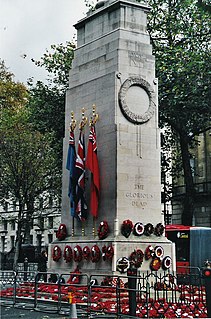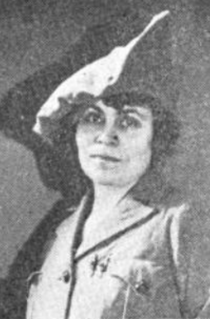
Remembrance Day is a memorial day observed in Commonwealth member states since the end of the First World War to honour armed forces members who have died in the line of duty. Following a tradition inaugurated by King George V in 1919, the day is also marked by war remembrances in many non-Commonwealth countries. In most countries, Remembrance Day is observed on 11 November to recall the end of First World War hostilities. Hostilities formally ended "at the 11th hour of the 11th day of the 11th month" of 1918, in accordance with the armistice signed by representatives of Germany and the Entente between 5:12 and 5:20 that morning. The First World War officially ended with the signing of the Treaty of Versailles on 28 June 1919.

"In Flanders Fields" is a war poem in the form of a rondeau, written during the First World War by Canadian physician Lieutenant-Colonel John McCrae. He was inspired to write it on May 3, 1915, after presiding over the funeral of friend and fellow soldier Lieutenant Alexis Helmer, who died in the Second Battle of Ypres. According to legend, fellow soldiers retrieved the poem after McCrae, initially dissatisfied with his work, discarded it. "In Flanders Fields" was first published on December 8 of that year in the London magazine Punch. Flanders Fields is a common English name of the World War I battlefields in Belgium and France.

A poppy is a flowering plant in the subfamily Papaveroideae of the family Papaveraceae. Poppies are herbaceous plants, often grown for their colourful flowers. One species of poppy, Papaver somniferum, is the source of the narcotic drug opium which contains powerful medicinal alkaloids such as morphine and has been used since ancient times as an analgesic and narcotic medicinal and recreational drug. It also produces edible seeds. Following the trench warfare in the poppy fields of Flanders, Belgium during World War I, poppies have become a symbol of remembrance of soldiers who have died during wartime, especially in the UK, US, and Canada.

Remembrance Sunday is held in the United Kingdom as a day to commemorate the contribution of British and Commonwealth military and civilian servicemen and women in the two World Wars and later conflicts. It is held on the second Sunday in November. Remembrance Sunday, within the Church of England, falls in the liturgical period of Allsaintstide.

The Australian War Memorial is Australia's national memorial to the members of its armed forces and supporting organisations who have died or participated in wars involving the Commonwealth of Australia and some conflicts involving personnel from the Australian colonies prior to Federation. Opened in 1941, the memorial includes an extensive national military museum.

The Royal Canadian Legion is a non-profit Canadian ex-service organization founded in 1925. Membership includes people who have served as military, Royal Canadian Mounted Police, provincial and municipal police, Royal Canadian Air, Army and Sea Cadets, direct relatives of members and also affiliated members. Membership is now also open to the general public.
The Royal British Legion (RBL), sometimes called the British Legion, is a British charity providing financial, social and emotional support to members and veterans of the British Armed Forces, their families and dependants.
The Haig Fund is a charity set up in 1921 by Field Marshal Douglas Haig, 1st Earl Haig.

The white poppy is a flower used as a symbol of peace, worn either in place of or in addition to the red remembrance poppy for Remembrance Day or Anzac Day.

The remembrance poppy is an artificial flower worn in some countries to commemorate their military personnel who died in war. Veterans' associations exchange poppies for charitable donations used to give financial, social and emotional support to members and veterans of the armed forces.
The Earl Haig Fund Scotland, trading as poppyscotland, is a Scottish charity for veterans of the British Armed Forces and their dependants. It was founded in 1921 by Douglas Haig, 1st Earl Haig as part of the broader British Haig Fund. Its main source of funding is the Scottish Poppy Appeal, organised in conjunction with the Royal British Legion in Scotland, which sells remembrance poppies in early November leading up to Remembrance Sunday. The first Poppy Appeal took place in 1921, and in 1926 Countess Haig established the Lady Haig's Poppy Factory in Edinburgh. The fund merged with The Royal British Legion in 2011 but operates as a distinct charity with the Legion.

The 80th Anniversary Armistice Remembrance Medal was a commemorative medal made to commemorate the 80th anniversary of the Armistice marking the end of World War I. Each of the 71 surviving Australian First World War veterans were presented with the medal for Anzac Day 1999. It is the first commemorative medal in the Australian Honours System.

The British grave of the Unknown Warrior holds an unidentified member of the British armed forces killed on a European battlefield during the First World War. He was buried in Westminster Abbey, London on 11 November 1920, simultaneously with a similar interment of a French unknown soldier at the Arc de Triomphe in France, making both graves the first to honour the unknown dead of the First World War. It is the first example of a tomb of the Unknown Soldier.

Moina Belle Michael was an American professor and humanitarian who conceived the idea of using poppies as a symbol of remembrance for those who served in World War I.

The Poppy Factory is a factory in Richmond, London, England, where remembrance poppies are made. It was founded in 1922 to offer employment opportunities to wounded soldiers returning from the First World War, creating remembrance products for the Royal Family and The Royal British Legion’s annual Poppy Appeal. It is operated by a company that is a registered charity which provides employment support to veterans with disabilities across England and Wales. The factory makes approximately 36 million poppies each year.
Major George Arthur Howson MC was an officer in the British Army in the First World War, and later the founder and chairman of the Royal British Legion Poppy Factory.

The Gibraltar Cross of Sacrifice is a war memorial in the British Overseas Territory of Gibraltar. It is located west of North Front Cemetery, at the junction of Winston Churchill Avenue and Devil's Tower Road. The Cross of Sacrifice was designed by Sir Reginald Blomfield in 1917, and his monument is found in numerous Commonwealth War Graves Commission cemeteries. The cross in Gibraltar was erected by the Royal Engineers for the commission, and unveiled on Armistice Day 1922. The British Pathé film recorded at the dedication ceremony that day represents the first motion picture made in Gibraltar. The Gibraltar Cross of Sacrifice served as the focus of Remembrance Sunday ceremonies in Gibraltar until 2009, at which time the location was changed to the Gibraltar War Memorial.

A remembrance cross is a small wooden cross used to remember the sacrifice of the armed forces in the United Kingdom, particularly during Remembrancetide, the period of the annual Poppy Appeal. Remembrance crosses are produced by the Poppy Factory in Richmond and Lady Haig's Poppy Factory in Edinburgh, which also produce remembrance poppies and wreaths. A remembrance cross is usually decorated with a remembrance poppy and the phrase "Remembrance" or "In Remembrance",

The Parliamentary War Memorial, also known as the Recording Angel Memorial, is a stone sculpture in Westminster Hall, unveiled in 1922, which commemorates the members of both Houses of Parliament of the United Kingdom who died in the First World War. It names 22 members of the House of Commons, 20 members of the House of Lords, and 9 senior members of staff, together with another 94 sons of members and officers of the House of Commons, who lost their lives in the war. Above the memorial is a large stained glass window which commemorates members and staff of both Houses who died in the Second World War.

Madame E. Guérin was born at Vallon (-Pont-d’Arc), Ardèche, France. She was the originator of the Remembrance Poppy Day. Prior to this, she was a teacher in Madagascar; a lecturer for the Alliance Française; and a lecturer, fundraiser and humanitarian in the United States, during World War I. For services to France, she was awarded the Officier d'académie’ médaille and the Officier de l’Instruction Publique médaille. For her services to the United States, for the Liberty Bond, she was awarded the Victory Liberty Loan Medallion.





















